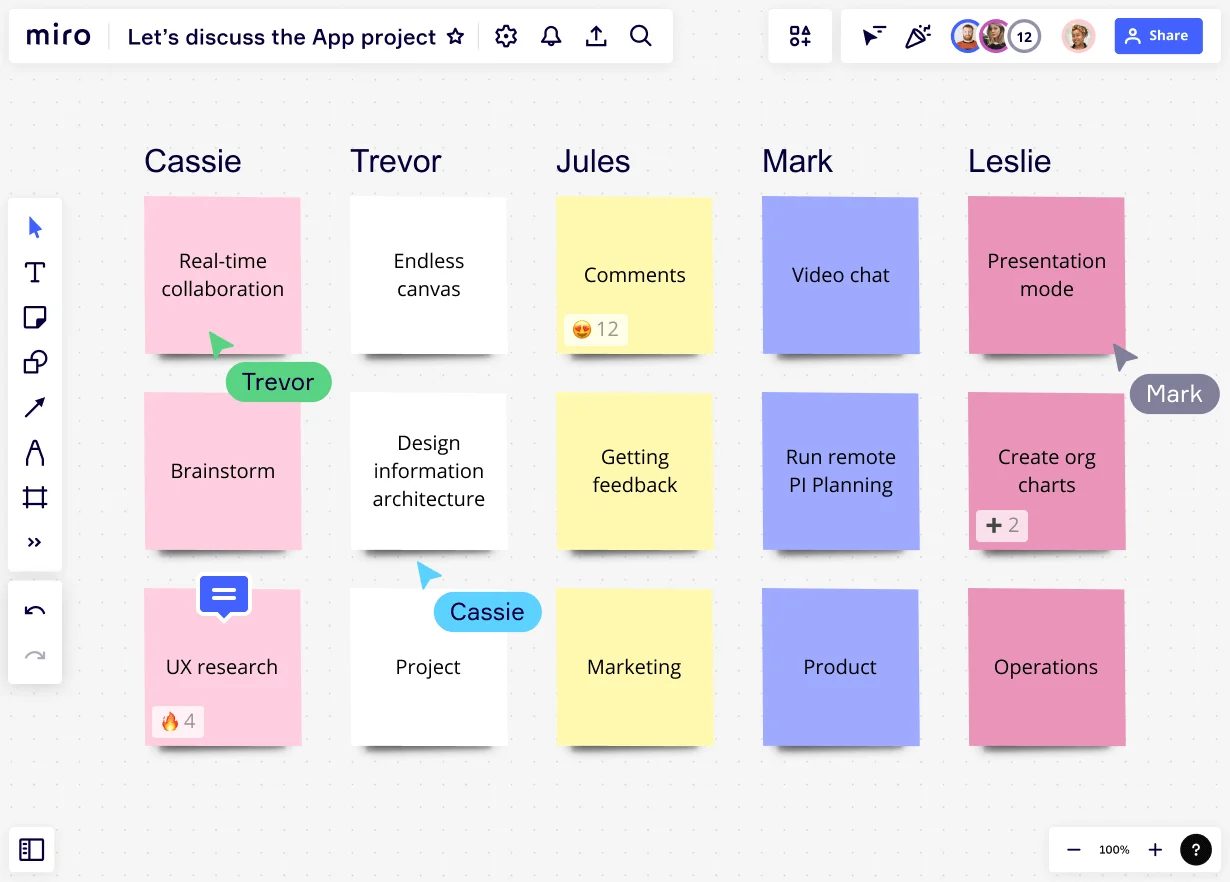
table of contents
table of contents
Collaborative brainstorming

Introduction: What is collaborative brainstorming?
Collaborative brainstorming is the rocket fuel of innovation, where multiple minds gather to collectively generate ideas. Unlike traditional brainstorming, where people ideate in isolation, collaborative brainstorming builds on the premise that 'two heads are better than one.' This potent technique allows diverse teams to tackle problems, find solutions, and conceptualize ideas, resulting in a broader range of innovative concepts and strategies.
Understanding how collaborative brainstorming works
Think of collaborative brainstorming as a colorful mosaic where each individual brings a unique piece. As these pieces interlock, they form a bigger picture that would be impossible to achieve alone. Similarly, in a collaborative brainstorming session, participants share their perspectives and build on each other's ideas, creating a synergy that enhances creativity and productivity.
In such a session, ideas aren't judged on their initial presentation; they are welcomed, explored, and expanded upon. Each idea is a potential seed that can sprout into a creative solution or innovative approach when nurtured in a collaborative setting.
For example, let's imagine your team needs to improve customer experience on your e-commerce platform. In a collaborative brainstorming session, a product manager might suggest a chatbot feature to fix real-time customer queries. Building upon that idea, the design expert might recommend integrating machine learning to personalize user interactions. The marketing specialist may propose leveraging this personalized data for targeted advertising. This ideation relay results in a well-rounded solution encompassing multiple perspectives and expertise.
What are the best collaborative brainstorming techniques?
While the end goal is the same – to generate a flurry of ideas – there are several different paths to reaching that objective. Here are three powerful techniques to maximize the efficiency of your collaborative brainstorming sessions:
1. Round-Robin Brainstorming: In this method, each participant shares an idea in turn, allowing for a structured flow of ideas. It's beneficial in ensuring equal participation and avoiding a scenario where more vocal people dominate the conversation.
2. Brainwriting: Often, some people are more comfortable expressing their ideas in writing. Participants write their thoughts using a brainwriting template, and everyone collectively reviews and builds upon them. This method allows for anonymous contributions, reducing the risk of idea judgment or bias.
3. Idea Mapping: Visual learners will appreciate this method. Participants create visual representations of their ideas – mind maps, flowcharts, diagrams – which others can add. This can be particularly powerful when using a tool like Miro, which enables real time, collaborative idea mapping on a shared workspace.
Advantages of running collaborative brainstorming sessions
Now that we've established how collaborative brainstorming works and outlined some techniques let's explore why it's such a valuable asset in the knowledge workspace.
1. Diversity of thought: Collaborative brainstorming invites a multitude of perspectives. Each participant brings their unique experiences, knowledge, and thinking style to the table. This diversity leads to a broader range of ideas, fosters innovation, and helps avoid tunnel vision.
2. Building team cohesion: As team members share and build on each other's ideas, they form deeper connections. This increased understanding and respect for each other's viewpoints foster a more cohesive, collaborative team environment.
3. Increased efficiency: By leveraging the collective brainpower of a group, you can generate ideas and solve problems more quickly than working individually. Additionally, the immediate feedback allows for rapid iteration and refinement of ideas.
How to run a collaborative brainstorm: Tips and tricks
Successful collaborative brainstorming requires more than just gathering a group and asking for ideas. Here are some tips to ensure you get the most out of your brainstorming sessions:
1. Define the problem clearly: Before you begin, make sure everyone understands the problem at hand. A well-defined problem provides direction and focus, ensuring the brainstorming session is productive.
2. Establish ground rules: To create a safe and open environment for ideation, set ground rules. These include respecting all ideas (no matter how outlandish), avoiding criticism, and ensuring everyone gets a chance to speak.
3. Use collaborative tools: Digital tools like Miro can dramatically enhance your brainstorming sessions. Miro's workspace allows participants to visually express, share, and build on ideas in real time, regardless of their location. It's like being in the same room, even if you're continents apart.
4. Facilitate, don't dominate: The role of the session facilitator is critical. They should guide the discussion, ensuring it stays on track and all voices are heard. However, they must avoid dominating the conversation or favoring their own ideas.
5. Encourage wild ideas: Sometimes, the most outlandish ideas can lead to the most innovative solutions. Encourage participants to think outside the box and share their wildest thoughts – you never know where they might lead.
6. Follow-up: Don't let the momentum fade once the session ends. Follow up with a summary of the ideas generated, and discuss the next steps for exploration and implementation.
Remember, the beauty of collaborative brainstorming lies in its collective nature. It's about breaking down silos, bridging minds, and creating a symphony of ideas. Whether designing the next user-friendly app or strategizing your marketing campaign, collaborative brainstorming can unlock creative solutions that are more than the sum of their parts. So gather your team, fire up Miro, and let the brainstorming begin!